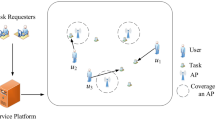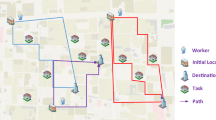Abstract
Mobile crowdsensing has become a new way to perceive and collect information due to the widespread of smart devices. In this paper, we study the task assignment problem in mobile crowdsensing systems, which is aimed to reducing the average and largest makespan of all tasks. We consider scenarios where task requester needs the help of mobile users for task completion when they encounter directly or through AP cloud (i.e., several APs connected via wired/wireless links) in an opportunistic manner. We describe the mobile crowdsensing system and formulate the problems under study. We first derive the conditional expected encountering time between requester and different users by jointly considering the opportunities via direct encountering and indirect encountering via AP cloud. Then we propose an AP-assisted average makespan sensitive online task assignment (AP-AOTA) algorithm and an AP-assisted largest makespan sensitive online task assignment (AP-LOTA) algorithm. We present detailed design for both algorithms. We deduce the computational complexities of both algorithms to be O(mn2), where m represents the number of tasks and n represent the number of users. We conduct simulations on a real trace data set and a synthetic trace data set and the results show that our proposed algorithms significantly outperform existing work.








Similar content being viewed by others
Notes
For this task re-assignment strategy to work smoothly, the AP cloud should have a task re-assignment module
References
Allahverdi A, NG CT, Cheng TCE, Kovalyov MY (2008) A survey of scheduling problems with setup times or costs. Eur J Oper Res 187(3):985–1032
Azzam R, Mizouni R, Otrok H, Quali A, Singh S (2016) Grs: a group-based recruitment system for mobile crowd sensing. J Netw Comput Appl 72:38–50
Cai H, Eun DY (2007) Crossing over the bounded domain: From exponential to power-law inter-meeting time in manet. In: Proceedings of the 13th Annual ACM International Conference on Mobile Computing and Networking, pp 159–170
Cheung MH, Southwell R, Hou F, Huang J (2015) Distributed time-sensitive task selection in mobile crowdsensing. In: Proceedings of the 16th ACM International Symposium on Mobile Ad Hoc Networking and Computing, pp 157–166
Chien T, Hsiang C (2015) Nccu trace: Social-network-aware mobility trace. IEEE Commun Mag 53 (10):144–149
Gong W, Zhang B, Li C (2017) Location-based online task scheduling in mobile crowdsensing. In: Proc IEEE GLOBECOM, vol 2017, pp 1–6
Gong W, Zhang B, Li C (2018) Task assignment in mobile crowdsensing: Present and future directions. IEEE Netw 32(4):100– 107
Gong W, Zhang B, Li C (2019) Location-based online task assignment and path planning for mobile crowdsensing. IEEE Trans Veh Technol 68(2):1772–1783
Han S, Xu S, Meng W, Li C (2017) An agile confidential transmission strategy combining big data driven cluster and obf. IEEE Trans Veh Technol 66(11):10259–10270
Han S, Zhang Y, Meng W, Chen H (2018) Self-interference-cancelation-based slnr precoding design for full-duplex relay-assisted system. IEEE Trans Veh Technol 67(9):8249–8262
He S, Shin D, Zhang J, Chen J (2017) Near-optimal allocation algorithms for location-dependent tasks in crowdsensing. IEEE Trans Veh Technol 66(4):3392–3405
Hsu W, Spyropoulos T, Psounis K, Helmy A (2007) Modeling time-variant user mobility in wireless mobile networks. In: Proc IEEE Conf Comput Commun, pp 758–766
Kang Y, Miao X, Liu K, Chen L, Liu Y (2015) Quality-aware online task assignment in mobile crowdsourcing. In: 2015 IEEE 12th International Conference on Mobile Ad Hoc and Sensor Systems, pp 127–135
Liu J, Li Y, Chen M, Dong W, Jin D (2015) Software-defined internet of things for smart urban sensing. IEEE Commun Mag 53(9):55–63
Liu Y, Guo B, Wang Y, Wu W, Yu Z, Zhang D (2016) Taskme: multi-task allocation in mobile crowd sensing. In: Proc the 2016 ACM International Joint Conference on Pervasive and Ubiquitous Computing, pp 403–414
Mun M, Reddy S, Shilton K, Yau N, Burke J, Estrin D, Hansen M, Howard E, West R, Boda P (2009) Peir, the personal environmental impact report, as a platform for participatory sensing systems research. In: Proc the 7th ACM International Conference on Mobile Systems, Applications, and Services, pp 55–68
Peng S, Gong W, Zhang B, Li C (2019) Ap-assisted online task assignment for mobile crowdsensing. In: 2019 IEEE Global Communications Conference (GLOBECOM), in press
Shi C, Lakafosis V, Ammar MH, Zegura EW (2012) Serendipity: Enabling remote computing among intermittently connected mobile devices. In: Proc 13th ACM Int Symp Mobile Ad Hoc Netw Comput, pp 145–154
Wang L, Zhang D, Pathak A, Chen C, Xiong H, Yang D, Wang Y (2015) Ccs-ta: Quality-guaranteed online task allocation in compressive crowdsensing. In: Proceedings of the 2015 ACM International Joint Conference on Pervasive and Ubiquitous Computing, pp 683–694
Wang X, Jia R, Tian X, Gan X (2018) Dynamic task assignment in crowdsensing with location awareness and location diversity. In: IEEE INFOCOM 2018 - IEEE Conference on Computer Communications, pp 2420–2428
Wang Z, Huang D, Wu H, Deng Y, Aikebaier A, Teranishi Y (2014) Qos-constrained sensing task assignment for mobile crowd sensing. In: Proc IEEE Global Communications Conference, pp 311–316
Xiao M, Wu J, Huang L, Cheng R, Wang Y (2017) Online task assignment for crowdsensing in predictable mobile social networks. IEEE Trans on Mob Comput 16(8):2306–2320
Xiong H, Zhang D, Chen G, Wang L, Gauthier V, Barnes LE (2016a) Icrowd: Near-optimal task allocation for piggyback crowdsensing. IEEE Trans Mob Comput 15(8):2010–2022
Xiong H, Zhang D, Chen G, Wang L, Gauthier V, EBarnes L (2016b) Icrowd: Near-optimal task allocation for piggyback crowdsensing. IEEE Trans on Mob Comput 15(8):2010–2022
Xu S, Han S, Meng W, Du Y, He L (2019) Multiple-jammer-aided secure transmission with receiver-side correlation. IEEE Trans Wirel Commun 18(6):3093–3103
Yang F, Lu J, Zhu Y, Peng J, Shu W, Wu M (2015) Heterogeneous task allocation in participatory sensing. In: 2015 IEEE Global Communications Conference (GLOBECOM), pp 1–6
Yang S, Wu F, Tang S, Luo T, Gao X, Kong L, Chen G (2016) Selecting most informative contributors with unknown costs for budgeted crowdsensing. In: Proc the 24th IEEE/ACM International Symposium on Quality of Service, pp 1–6
Yao H, Xiong M, liu C, Liang Q (2017) Encounter probability aware task assignment in mobile crowdsensing. Mob Netw Appl 22(2):275–286
Yu Z, Feng Y, Xu H, Zhou X (2014) Recommending travel packages based on mobile crowdsourced data. IEEE Commun Mag 52(8):56–62
Zhao Q, Zhu Y, Zhu H, Cao J, Xue G, Li B (2014) Fair energy-efficient sensing task allocation in participatory sensing with smartphones. In: IEEE INFOCOM 2014 - IEEE Conference on Computer Communications, pp 1366–1374
Zheng Y, Xie X, Ma WY (2010) Geolife: a collaborative social networking service among user, location, and trajectory. IEEE Data Eng Bull 33(2):32–39
Acknowledgements
This work was supported in part by the NSF of China under Grant Nos. 61872331, 61872031, 61471339, the Natural Sciences and Engineering Research Council (NSERC) of Canada (Discovery Grant RGPIN-2018-03792), and the InnovateNL SensorTECH Grant 5404-2061-101.
Author information
Authors and Affiliations
Corresponding author
Additional information
Publisher’s Note
Springer Nature remains neutral with regard to jurisdictional claims in published maps and institutional affiliations.
Appendix
Appendix
In this appendix, we present the detailed derivation process of Eqs. 6 and 7.
1.1 A. Derivation Process of (6)
Expand Eq. 6, we have
Combine Eqs. 4, 5 and 14, we can get
1.2 B. Derivation Process of (7)
Expand Eq. 7, we have
Combine Eqs. 4, 5 and 16, we can get
Rights and permissions
About this article
Cite this article
Peng, S., Gong, W., Zhang, B. et al. AP-Assisted Online Task Assignment Algorithms for Mobile Crowdsensing. Mobile Netw Appl 25, 1694–1707 (2020). https://doi.org/10.1007/s11036-020-01579-3
Published:
Issue Date:
DOI: https://doi.org/10.1007/s11036-020-01579-3




